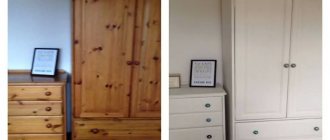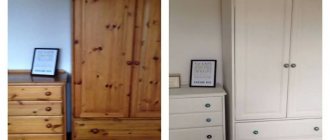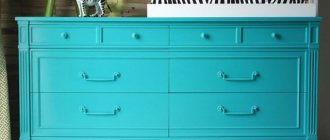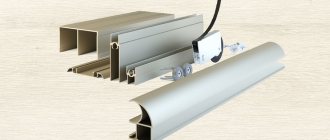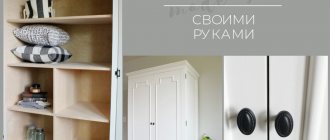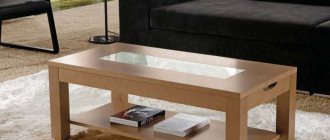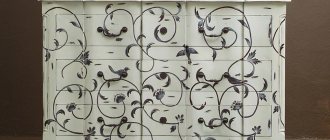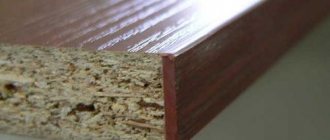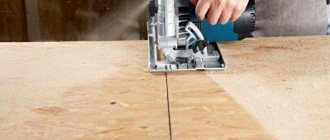An old wardrobe or chest of drawers rarely looks attractive, especially after renovation. Replacing furniture is a troublesome and costly task, so the question: how to repaint a cabinet a different color at home remains relevant. We'll figure out how to properly update a cabinet, what you'll need for the job, and what paints and varnishes you can use.
Furniture before and after transformation Source pinimg.com
What we paint
The need to change the color of furniture arises for various reasons. The item no longer fits in with the recent renovation, becomes obsolete, or simply gets boring. Professional restoration is not always available, but anyone who has ever held a brush in their hands can master the basic techniques.
Coloring is the simplest and most understandable process with simple recommendations. Furniture preparation plays an important role in it, and it depends on the type of surface. The easiest way to prepare a wooden cabinet, chest of drawers or bedside table. In practice, solid wood products are most often of Swedish origin and come into the home from the IKEA store. Many of them are sold unpainted, which makes the task much easier.
IKEA furniture is comfortable and versatile, but it is often repainted by those who find Scandinavian design too boring. Most of the remaining items are furniture made of chipboard or MDF in film (for example, a kitchen), or lacquered products. They require longer preparation.
Chest of drawers in the bedroom interior Source pinimg.com
How to paint MDF furniture at home?
Share on social media networks:
Sooner or later, any person has an irresistible desire to change something in the ordinary interior of his house or apartment. Often the usual rearrangement of furniture does not bring satisfaction and does not achieve the desired effect. In such cases, it helps to radically change the appearance of interior items by painting them. Considering the fact that most modern furnishings are made from inexpensive and widely available materials, today we will learn how to paint MDF furniture at home without the help of specialists.
What you will need
For work you will need the following tools and materials:
- A dense roller (or a pen attachment with two or three replaceable rollers). The width is chosen depending on the size of the cabinet (chest of drawers), on average 10-15 cm. A roller will help to evenly roll out the paint on a large surface, and the result will be good the first time. Select the tray according to the size of the roller.
- Two or three soft brushes of different sizes with artificial bristles. Hard bristles are not recommended as they will leave streaks that are difficult to get rid of. Brushes are needed for painting elements of complex shapes, where a roller cannot cope.
- Screwdriver Set. You will have to remove the fittings and most likely disassemble the furniture. The work will be more comfortable and of higher quality if you simply remove the doors.
- Masking tape. You will need it to protect small parts that cannot be removed. For example, if there are built-in lamps in the closet, they are removed, but left hanging and protected with tape.
A tool you can’t do without Source pinimg.com
- Sandpaper (sandpaper) of different formats: fine (soft) and coarse.
- New hardware if you are going to change the style of the cabinet or make it more original. The easiest way to find suitable handles is in large and specialized online stores - the choice of accessories there is truly limitless.
- Paint and varnish materials: paint, varnish, and degreasing solvent.
- You always need rags (napkins); polyethylene comes in handy to protect the surrounding area from paint.
Optionally the following items can be used:
- Sander, safety glasses and gloves.
- Spatula and putty.
- If a large area will be treated, a sprayer is convenient.
Applying varnish to a countertop Source premium.vgc.no
How to create color transitions and painting
It is not difficult to create a unique piece of furniture. To do this, you can decorate the cabinet with painting, a color gradient, create a textured surface, or use a stencil in the design. The choice of method depends only on the imagination of the owner and the design of the room.
The drawing is applied to an already painted base with acrylic paints. The theme is chosen in accordance with the design of the room. Geometric motifs, patterns, and flower images look very attractive. A cabinet decorated as an antique can be decorated with gold ornaments.
A new trend in furniture fashion is color gradient. To create a smooth transition of shades of the same color, paints with different amounts of pigment are used or additional colors are purchased. This design looks especially good in a children's room or teenager's bedroom.
Color is especially important in a child's room
How to paint so that the surface is cracked
Artificial aging - craquelure - looks beautiful. To achieve the cracking effect, use a special varnish. The thicker its layer, the wider the cracks become. After drying, the cabinet is treated with a matte protective varnish.
Cracked facades - craquelure technique
Stencil painting: master class
Using a stencil allows you to get a unique painting on furniture. The pattern is applied to an already painted surface, and after drying it is covered with matte varnish for protection:
- Choose paint with a semi-liquid or thick consistency to prevent bleeding from under the stencil.
- Prepare a foam roller or swab. The cabinet must be pre-painted in the main color.
- Place the stencil on the surface and, if possible, secure it with masking tape to prevent movement while working.
- Dip the swab into the paint and apply light pressure to the holes of the stencil.
Paint selection
Paints and varnishes vary in composition and such important parameters as transparency and gloss level. When looking for a suitable option, you should avoid oil paint with its heavy smell and long drying period. Toxic and flammable solvent-based materials are of little use.
In order to repaint a cabinet in a different color, water-based paints that are marked “furniture” are optimal. A common feature of such compositions is environmental friendliness, which is important in the case of repainting objects located in a residential area. They practically do not emit volatile organic matter and therefore do not have a pungent odor. The compositions are fireproof and do not cause allergic reactions.
Paint color is only one of the selection criteria Source kraskidlyamebeli.ru
Acrylic
These compositions are the most affordable and therefore widespread among water-based analogues. The lack of toxicity is combined with wear resistance and the ability to pass air. The latter quality helps the wood regulate moisture (breathe), thereby minimizing the appearance of mold and mildew.
It must be taken into account that acrylic compounds do not always cope with repainting. The main disadvantage of acrylic is that it does not adhere to the surface of furniture made from chipboard. It also makes no sense to buy acrylic paint for glossy (varnished) facades or products previously painted with an adhesive-based composition.
Acrylic dyes dry fairly quickly, but the polymerization process (especially if primer was used) can take more than a month. And, although after repainting the item is almost immediately ready for use, the coating requires careful handling; it can be easily scratched or damaged by accidental force.
Repainting drawers is a quick way to refresh the design Source livejournal.com
See also: Catalog of companies that specialize in paints and varnishes and related work
Acrylic is easy to work with. To achieve the desired color saturation, just dilute the paint with water. It is easy to wash off if you are wrong with the shade and decide to repaint the fragment again.
Acrylic dyes are also sold in aerosol form, which is quite convenient for repainting large surfaces if you know how to use them. When choosing a suitable shade, you can paint over a small area of the surface. This will help you evaluate which color looks best on a given basis.
Alkyd
The basis of alkyd paints is an organic solvent; the compositions resist moisture well, which makes them convenient to use for painting furniture in the kitchen and bathroom. The peculiarity of the dye is that it creates a film coating with a thickness of no more than 0.1 mm. The service life of such coating will be short.
Color completely changes perception Source homeproved.com
Eco-paints
Chalk, milk or mineral paint can be a worthy alternative to acrylic compositions. Eco-paints are made from natural materials, therefore they do not have a strong odor, are hypoallergenic, and do not harm people and pets.
Thanks to their composition, they lie smoothly not only on wood, but also on complex surfaces of laminated chipboard, chipboard, and MDF.
Eco-paint can also be used to paint lacquered furniture, and in most cases the surface does not have to be specially prepared (for example, primed). The composition will adhere well, forming a durable layer, if you sand the furniture a little with sandpaper to slightly reduce the shine.
Other
You can also paint your favorite cabinet with silicone or latex-based water-based paint. The silicone layer is not afraid of moisture, lasts a long time and is interesting because it can fill and mask small cracks.
The latex composition is viscous and resembles oil paint. But at the same time, it does not have a pungent odor, and it lasts much longer. The only limitation of latex coating is that it can crack at low temperatures, but this is not important for home use.
Using chalk paint Source blog.postel-deluxe.ru
Varnishes and tinting impregnations
They change the appearance of furniture, so they can be classified as coloring compounds. This group of paints and varnishes performs not only a decorative, but also a protective function. Penetrating into the structure of wooden furniture, impregnations and varnishes prevent the appearance of mold and pests.
Priming
Experts advise purchasing paint at the same time as the primer, from the same manufacturer and on the same base. This will significantly improve the adhesion of the dye to the furniture surface.
The best results are achieved with a water-based adhesive primer. It is especially helpful in the case of difficult surfaces (for example, chipboard), where the dye does not adhere well and does not adhere well. If you plan to repaint a dark cabinet light, use a white primer; If you want to turn a light chest of drawers into a dark one, you will need a dark primer.
A light primer was used here Source pinimg.com
To varnish or not
The varnish coating fixes the color, protects the surface of the furniture, and the product looks antique and well-groomed. Be sure to protect with varnish the furniture that is often opened and closed.
For varnishing, use specialized furniture (not parquet) matte or transparent varnishes. The second layer is applied 24 hours after the first coating.
Varnish choice:
Alcohol varnish is used when restoring antique objects.
New, popular acrylic varnish, odorless, suitable for indoor and outdoor use. Economical product - water is used for dilution.
Durable alkyd varnish film withstands abrasion. A solvent is used for dilution.
Little oil varnish is used; it is often used to cover the floor. For dilution you need drying oil that dries for at least a day.
Polyurethane (ship) varnish has increased wear resistance due to the appearance of a protective, quick-drying film.
Nitrovarnishes are inexpensive and form a durable protective film. No special primer is required before coating. When applied, it is diluted with a solvent.
Preparing furniture: where to start
Preparation begins with removing dirt, old stains and odors. The easiest way to do this is with a sponge soaked in washing powder or soap solution. After washing, stubborn stains remain, which can be removed with vinegar, acetone or white spirit. To make it convenient to work, move the furniture away from the wall, put on a protective mask and gloves, and do not forget to ventilate the room.
After washing, the surface is allowed to dry, then the old coating is removed. They do this in one of the following ways:
- Mechanical. The fastest way to do this is with a grinder and a wide spatula. In hard-to-reach places, remove the varnish coating using a flat-tip screwdriver.
- Chemical. To remove old polish, special solvent-based removers are used. The composition is applied to the surface of the cabinet for the time specified in the instructions. Once the reaction is complete, the remaining material is removed with coarse sandpaper or a spatula.
Design in fashionable white color Source gidpokraske.ru
- Thermal. The old varnish or film coating peels off and is easily removed after heating with a hair dryer. If the film does not lend itself, it is left and painted over it, having first sanded it.
After the old coating is removed, the surface is lightly sanded to remove any small residues. If the furniture is wooden, sanding is carried out in the direction of the grain. The task is performed in three steps: first use coarse-grained sandpaper, then use medium-grained sandpaper, and finally use fine-grained sandpaper.
At this stage, the cabinet is carefully inspected so as not to miss any defect. If the item is large, it is more convenient to dismantle it; It is easier to paint individual parts, and the result is of higher quality.
Common mistakes
The technology requires appropriate humidity (no more than 50%) and temperature (no lower than 20°C and no higher than 24°C). Therefore, paint and varnish work should be carried out indoors using lung protection.
The easiest way to change is the light base of the surface. When using stain (for wood) or colored varnish, you will get a darker facade, but at the same time maintain the structure of the material. If your base is dark, then it is more difficult to emphasize its structure.
The easiest way to get the desired tone is by mixing the desired colors several times in different dishes. Check the result on test surfaces and when the paint has dried, you will be able to make a more accurate choice.
Video description
About updating an old cabinet in the following video:
Preparation for painting: primer
All cabinet parts intended for painting are dusted and degreased. To do this, wipe the surface with a damp cloth, and then with a cloth moistened with alcohol or a special degreaser. At this stage, care is needed: the slightest particles of glue from the film must be sanded off and degreased.
Dining group in a pastel palette Source archidea.com.ua
Identified defects (scratches, cracks and small irregularities) are eliminated using a special wood putty. After waiting for the composition to dry, the treated areas are sanded and degreased again to level the surface. As a result of the work done, the surface of the product should be completely covered with a network of small scratches.
The primer helps the paint composition adhere better to the surface. It is recommended to prime in two layers, allowing each to dry. Then you need to go over the surface with fine sandpaper again; This must be done carefully so as not to remove the soil. Additional sanding will enhance adhesion, if you remember to thoroughly wipe off the dust afterwards.
Materials and tools required for work
To prepare and repaint the cabinet, you will need the following tools:
- brush, paint roller or spray gun;
- paper-based tape;
- putty knife;
- sandpaper with an abrasive layer of medium and fine fraction;
- block for securing the emery.
A spray gun is a convenient tool that requires experience and dexterity, but allows you to get a very even layer
Using a grinding machine or drill with special attachments will help speed up the preparatory work. In addition, you will need a wide container of water and rags for drying and cleaning the surface to be treated.
The master himself determines what is more convenient for him to work with - a roller or a brush.
The brush applies the paint carefully, the layer is evenly distributed over the surface to be treated. Using this tool it is convenient to paint small furniture elements, as well as places where it is difficult to reach.
It's better to have several brushes on hand. A wide one will be needed for applying enamel to parts with a large smooth surface. It is more convenient to handle corners, panels and other decorative elements with a thin brush.
Coloring
The surface is covered with paint in 2-3 layers. If the first layer turns out to be uneven, with bald spots, the defects are corrected during the second painting. After drying, the first layer can be lightly sanded with fine sandpaper. This grinding has two purposes. It removes sagging and grooves of paint, and makes the surface matte, so that the next layer will adhere better.
After the first coloring Source mebelnada.com.ua
How to repair cracks
You can often find chips, scratches, and cracks on old furniture. They must be removed before painting. To do this you need to use putty.
To prevent the restoration material from crumbling after drying, it is necessary to pre-treat the defect with a primer solution. Experts recommend using automotive primer. This high quality product is suitable for use on dense wood.
After applying the putty, the surface of the cabinet is sanded. And then remove dust and remaining putty material with a damp cloth.
Briefly about the main thing
Repainting a cabinet a different color on your own is a simple job that only requires care, time and a set of necessary tools. The process is divided into several stages. The main task is to create a rough surface that helps the paint lie evenly and tightly. The cabinet is first cleaned, defects are repaired and primed.
The main problem may arise when removing the old varnish or film layer. It is solved mechanically, chemically or thermally. The paint is applied in several layers, the number of which allows you to emphasize or hide the texture of the base. For the finishing coat, choose wax or water-based or polyurethane-based varnish.
Professional recommendations
It is not recommended to use aerosol cans for painting furniture facades. Their main advantage is ease of use. As for the quality of the coating, professionals have many complaints about it.
Spray paint
To paint MDF wall paneling with rollers, buy them with fine pile. Such rollers leave fewer marks, the paint goes on more evenly and has time to level out during drying.
Short nap roller
The longer the paint dries, the more defects it can hide on its own. Quick-drying materials do not provide such an advantage; the surface dries out quickly and is poorly leveled.
Absolutely all MDF boards emit chemical compounds into the air. The notorious “environmental friendliness” depends only on their quantity. In different countries, sanitary control authorities set their own acceptable standards. What is considered harmful by some is considered environmentally friendly by others and is allowed for use. The amount of harmful compounds released can be minimized by deep impregnation. This is another reason not to abandon this operation when painting MDF.
If problem areas are discovered on the surface after the work is completed, they can be hidden with overhead decorative elements. Now on sale there is a large selection of designs on self-adhesive polyethylene film. With them you will not only hide your defect, but will give the surfaces a beautiful, exclusive look.
The pile on MDF boards does not rise; only natural wood has this disadvantage
When choosing paints and varnishes, pay attention to this feature. By the way, coatings that do not raise the pile during drying are much more expensive than ordinary ones; do not overpay for unnecessary properties
Painted MDF
